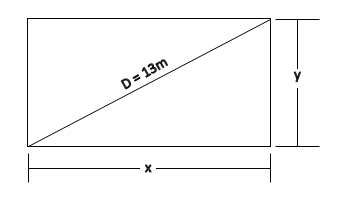
A took 15 seconds to cross a rectangular field diagonally walking at a rate of $52\,m/\min $and B took the same time to cross the same field along its sides, walking at the rate of $68\,m/\min $. The area of the field is:
A. $30\,{{m}^{2}}$
B. $40\,{{m}^{2}}$
C. $50\,{{m}^{2}}$
D. $60\,{{m}^{2}}$
Answer
579k+ views
Hint: A crosses the rectangular field diagonally means it travels along the diagonal, and B crosses along its side means it travels along the boundary line of the rectangle. The area of the rectangle is calculated by length x breadth. Rate is the speed at which A and B are travelling . Here, the area of the field is the area of the rectangle.
Complete step by step solution:.

Step 1: Rate of A=$52\,m/\min $ =$\dfrac{52}{60}\,m/\sec $=$\dfrac{13}{15}\,m/\sec $
Rate of B=$68\,m/\min $ =$\dfrac{68}{60}\,m/\sec $ =$\dfrac{17}{15}\,\,m/\sec $
Step 2: Distance travelled by A= $Rate\,of\,A\,\times \,\,time\,taken$=$\dfrac{13}{15}\,\times 15$ =$13\,m$
Distance travelled by B= $Rate\,of\,B\,\times \,time\,taken$=$\dfrac{17}{15}\,\times 15$ =$17\,m$
Step 3: Since B crosses the field along its sides therefore, it is basically sum of two sides of rectangle i.e
$x+y=17$
Squaring both sides we get,
\[\begin{align}
& \\
& {{(x+y)}^{2}}={{(17)}^{2}} \\
& {{x}^{2}}+{{y}^{2}}+2xy={{(17)}^{2}} \\
& {{(D)}^{2}}+2xy={{(17)}^{2}}\,\,\,[\because {{x}^{2}}+{{y}^{2}}={{D}^{2}}]\, \\
&2xy={{(17)}^{2}}\,-{{(D)}^{2}} \\
&2xy={{(17)}^{2}}\,-{{(13)}^{2}}\,\,\,\,\,\,[\because D\,is\,dis\tan ce\,traveled\,by\,A]\,\,\, \\
&2xy=289-169 \\
&2xy=120 \\
&xy=60{{m}^{2}} \\
& \\
& \, \\
\end{align}\]
∴$xy$ is the area of the rectangular field. It comes out to be $60\,{{m}^{2}}$
Note: In this type of questions students often get confused while determining the path. Do not make this mistake and don’t forget to use the Pythagoras theorem.
Complete step by step solution:.

Step 1: Rate of A=$52\,m/\min $ =$\dfrac{52}{60}\,m/\sec $=$\dfrac{13}{15}\,m/\sec $
Rate of B=$68\,m/\min $ =$\dfrac{68}{60}\,m/\sec $ =$\dfrac{17}{15}\,\,m/\sec $
Step 2: Distance travelled by A= $Rate\,of\,A\,\times \,\,time\,taken$=$\dfrac{13}{15}\,\times 15$ =$13\,m$
Distance travelled by B= $Rate\,of\,B\,\times \,time\,taken$=$\dfrac{17}{15}\,\times 15$ =$17\,m$
Step 3: Since B crosses the field along its sides therefore, it is basically sum of two sides of rectangle i.e
$x+y=17$
Squaring both sides we get,
\[\begin{align}
& \\
& {{(x+y)}^{2}}={{(17)}^{2}} \\
& {{x}^{2}}+{{y}^{2}}+2xy={{(17)}^{2}} \\
& {{(D)}^{2}}+2xy={{(17)}^{2}}\,\,\,[\because {{x}^{2}}+{{y}^{2}}={{D}^{2}}]\, \\
&2xy={{(17)}^{2}}\,-{{(D)}^{2}} \\
&2xy={{(17)}^{2}}\,-{{(13)}^{2}}\,\,\,\,\,\,[\because D\,is\,dis\tan ce\,traveled\,by\,A]\,\,\, \\
&2xy=289-169 \\
&2xy=120 \\
&xy=60{{m}^{2}} \\
& \\
& \, \\
\end{align}\]
∴$xy$ is the area of the rectangular field. It comes out to be $60\,{{m}^{2}}$
Note: In this type of questions students often get confused while determining the path. Do not make this mistake and don’t forget to use the Pythagoras theorem.
Recently Updated Pages
Master Class 9 Social Science: Engaging Questions & Answers for Success

Master Class 9 Science: Engaging Questions & Answers for Success

Master Class 9 English: Engaging Questions & Answers for Success

Master Class 9 Maths: Engaging Questions & Answers for Success

Master Class 9 General Knowledge: Engaging Questions & Answers for Success

Class 9 Question and Answer - Your Ultimate Solutions Guide

Trending doubts
Which places in India experience sunrise first and class 9 social science CBSE

Fill the blanks with the suitable prepositions 1 The class 9 english CBSE

Write the 6 fundamental rights of India and explain in detail

Difference Between Plant Cell and Animal Cell

What is pollution? How many types of pollution? Define it

What is the Full Form of ISI and RAW




